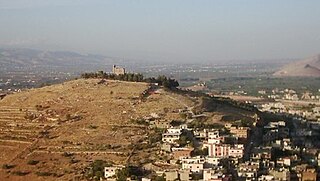Related Research Articles

Bechamoun, is an area near Beirut in the Mount Lebanon Governorate of Lebanon. It has an elevation between 40 and 580 meters above sea level, 8 kilometers from Beirut airport and Beirut downtown. Bechamoun's population exceeds 15,000.

Majdal Anjar is a village of Beqaa Governorate, Lebanon. Majdal Anjar is an overwhelmingly Sunni Muslim town.

Sin el-Fil is a suburb east of Beirut in the Matn District of the Mount Lebanon Governorate, Lebanon.

Kaukaba, Kaukabet El-Arab or Kaukaba Station is a village in the Hasbaya District in the Nabatiye Governorate in southern Lebanon.

Archaeology of Lebanon reveals thousands of years of history ranging from the Lower Palaeolithic, Phoenician, Jewish, Roman, Muslim, Christian, Ottoman, and Crusades history.

Labweh, Laboué, Labwe or Al-Labweh is a village at an elevation of 950 metres (3,120 ft) on a foothill of the Anti-Lebanon Mountains in Baalbek District, Baalbek-Hermel Governorate, Lebanon.
Hashbai or Tell Hashbai is an archaeological site on the west of the Beqaa Valley in Lebanon.
Ard Tlaili or Tell Ard Tlaili is a small tell mound archaeological site in a plain at the foot of the Lebanon Mountains 11 km (7 mi) northwest of Baalbeck, in the Beqaa Valley in Lebanon.
Ras Baalbek I is a rock shelter 500 m (1,600 ft) east of Ras Baalbek in the northern Beqaa Valley in Lebanon. It sits north of the Wadi Teniyet er-Râs valley at a height of 1,000 m (3,300 ft). It was first discovered by Lorraine Copeland and Peter Wescombe in 1965–1966. It was later excavated by Jacques Besançon in 1970. Retouched blades along with a pressure-flaked arrowhead and a burin were found dated to the Neolithic period.
Tell Neba'a Litani or Neba'a Litani is a medium size tell 9 kilometres (5.6 mi) west of Baalbek in the northern Beqaa Valley of Lebanon. I It is located near the spring which is the main source of the Litani River at a height of 1,002 metres (3,287 ft). It was first studied by Lorraine Copeland and Peter Wescombe in 1965-1966 and is accessible via a road which turns from Hoch Barada to the left. Materials recovered included flint tools such as scrapers and the blade from a segmented sickle. Pottery included burnished, painted and red-washed shards, some with incised decoration or lattice patterns. The material resembled finds from Byblos and Ard Tlaili leading Copeland and Wescombe to suggest a late Neolithic occupation for the tell that extended into the Bronze Age.
Tell Ain Nfaikh or Ain Nfaikh is an archaeological site in an area c. 100 square metres (1,100 sq ft) of a ploughed field 300 metres (980 ft) east of the Litani, north of Rayak on the west of the Beqaa Valley in Lebanon.
Tell Jisr, Tell el-Jisr or Tell ej-Jisr is a hill and archaeological site 1.5 kilometres (0.93 mi) northwest of Joub Jannine in the Beqaa Valley in Lebanon.
Aammiq is a village in the Western Beqaa District in Lebanon. It is also the name of an archaeological site.
The Sands of Beirut were a series of archaeological sites located on the coastline south of Beirut in Lebanon.
Tell Zeitoun also called Tell Dnaibe, is an archaeological site 8 kilometres (5.0 mi) southwest of Rashaya in Lebanon at an altitude of 900 metres (3,000 ft).
White Ware or "Vaisselle Blanche", effectively a form of limestone plaster used to make vessels, is the first precursor to clay pottery developed in the Levant that appeared in the 9th millennium BC, during the pre-pottery (aceramic) neolithic period. It is not to be confused with "whiteware", which is both a term in the modern ceramic industry for most finer types of pottery for tableware and similar uses, and a term for specific historical types of earthenware made with clays giving an off-white body when fired.

Qaraoun is a Lebanese village, 85 km from Beirut, known for its Lake Qaraoun in the Beqaa Valley formed by the El Wauroun Dam built in 1959. It is an ecologically fragile zone in the Western Beqaa District. The village lies about 800 m above sea level. The dam is located nearby on the Litani River.
Tahun ben Aissa is an archaeological site about 3.5 kilometres southwest of Joub Jannine in the Beqaa Valley in Lebanon.
Tell Deir is an archaeological site approximately halfway between Joub Jannine and Chtaura in Lebanon, and a large landmark in the Beqaa Mohafazat (Governorate). It dates at least to the Neolithic.
Antelias Cave was a large cave located 2.5 km (1.6 mi) east of Antelias, 10 km (6.2 mi) northeast of Beirut close to the wadi of Ksar Akil.
References
- ↑ Lorraine Copeland; P. Wescombe (1965). Inventory of Stone-Age sites in Lebanon. Imprimerie Catholique. Retrieved 15 March 2011.
- ↑ Copeland, Lorraine, "Neolithic Village Sites in the South Beqaa Lebanon", Melanges de l'Université Saint-Joseph (Beirut Lebanon) Volume 45, (Pages 83-114), 1969.
- ↑ Gopher, A., Sixth-fifth millennia B.C. settlements in the Coastal Plain, Israel., pp.55-63, Paleorient, Volume 19, 1993.
- ↑ Moore, A.M.T. (1978). The Neolithic of the Levant. Oxford University, Unpublished Ph.D. Thesis. pp. 192–198.
- ↑ Mellart, James, The Neolithic of the Near East, p. 64, Scribner, 1975.
- ↑ Dornermann, Rudolph Henry, A Neolithic village at Tell el Kowm in the Syrian Desert, p. 58, Oriental Institute of the University of Chicago, 1986.
- ↑ Haïdar-Boustani, Maya. "Le Néolithique du Liban dans le contexte Proche-Oriental", Annales d'hitoire et d'archéologie p. 22, (Université Saint-Joseph, Beirut) Vol. 12-13, 2001-2002, ISSN 1729-6927
- ↑ Dineley, Merryn., Barley Malt and Ale in the Neolithic, M. Phil Thesis submitted to University of Manchester, Department of Art History and Archaeology, 1999.
- ↑ Evin, Jacques & Hours, Francis, Chronologies du Proche Orient, Parts 1-2, pp. 405 & 424, Centre national de la recherche scientifique (France), B.A.R., 1987.